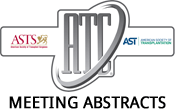2018 American Transplant Congress
Ablation of Both mTOR and STAT3 in T Cells Induces Heart Transplant Acceptance in Donor Skin-Sensitized Mice
Allogeneic memory T cell response precludes the induction of transplant acceptance; how this process is regulated at the molecular level remains unclear. Both mTOR and…2018 American Transplant Congress
The Role of pDCs in Formation of Treg-Rich Organized Lymphoid Structures in Spontaneously Accepted Murine Kidney Allografts is Dependent on Mismatching of MHC Class II Molecules at the H2-I-Ab Locus
Introduction: Our lab has demonstrated that murine kidney allografts are spontaneously accepted in specific donor-recipient strain combinations. Histologic examination of spontaneously accepted DBA/2J (DBA) kidneys…2018 American Transplant Congress
Simultaneous Persistence and Development of Donor and Recipient Tissue Resident Memory T Cells in Lung Transplantation
Introduction: The predominant T cell population in the lung comprises non-circulating tissue-resident memory T cells (TRM); however, the fate of these cells in transplanted lung…2018 American Transplant Congress
Contribution of mTOR Signaling to the β-Catenin Pathway in Regulatory T Cells
Surgery, University of Kentucky, Lexington, KY.
Background: A growing body of evidence recognizes the balance between graft-reactive effector T cells and graft-protective regulatory T cells (Tregs) as the ultimate determinant of…2018 American Transplant Congress
CD4 T Cells Require Both S1PR1 and S1PR4 for Afferent Lymphatic Migration
1UMB, MD; 2NIH, MD; 3Boston Children's Hospital, MA; 4NYU, NY; 5U. Minnesota, MN.
Introduction: Sphingosine 1-phospate (S1P) receptor 1 (S1PR1) drives T cell migration from thymus into blood, and lymph nodes (LN) into efferent lymphatics. Whether S1PR1 and…2018 American Transplant Congress
Prolongation of Skin Allograft Survival through Dietary Supplementation of Ayrl Hydrocarbon Receptor Ligands
Transplant Surgery, University of Wisconsin, Madison, WI.
The Aryl Hydrocarbon Receptor (AHR) is a cytosolic transcription factor with numerous endogenous and xenobiotic ligands playing a key role in a number of cellular…2018 American Transplant Congress
Aquaporin 4 Blockade Alters T Cell Trafficking through a Novel Mechanism of S1PR1 Regulation
1Immunology, Cleveland Clinic, Cleveland, OH; 2Aeromics LLC, Cleveland, OH.
The ubiquitous water channels aquaporins mediate a variety of immune functions. We previously demonstrated that aquaporin 4 (AQP4) is expressed by CD4 and CD8 T…2018 American Transplant Congress
Inhibition of IL-1R1 Signaling Delays Costimulation Blockade–Resistant Allograft Rejection by Preventing CD8 TEM Expansion
Department of Surgery, Emory University, Atlanta, GA.
The clinical utilization of Costimulaiton Blockade (CoB) led to improved long-term patient outcomes, but wider adoption of is hampered by increased rates of acute cellular…2018 American Transplant Congress
Lymphatic Endothelium Requires S1PR2 for T Cell Transendothelial Migration
1UMB, MD; 2NIH, MD; 3Boston Children's Hospital, MA; 4NYU, NY; 5U. Minnesota, MN.
Introduction: Sphingosine 1-phosphate (S1P) receptors 1 (S1PR1) and S1PR2 are highly expressed by lymphatic endothelial cells (LEC), while T cells express S1PR1 and S1PR4. S1P…2018 American Transplant Congress
CD4+CD25bright Regulatory T Cells Prevent Acute Xenogeneic GVHD
Institute for Cellular Therapeutics, University of Louisville, Louisville, KY.
Graft-versus-host disease (GVHD) is a major complication and limitation to the broad application of hematopoietic stem cell transplantation. Cell therapy has emerged as a promising…
- « Previous Page
- 1
- …
- 27
- 28
- 29
- 30
- 31
- …
- 53
- Next Page »
